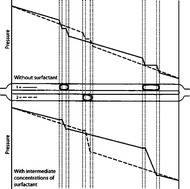The pressure drop along rectangular microchannels containing bubbles†
Abstract
This paper derives the difference in pressure between the beginning and the end of a rectangular microchannel through which a flowing liquid (

* Corresponding authors
a
Department of Chemistry and Chemical Biology, Harvard University, Cambridge, Massachusetts 02138, USA
E-mail:
gwhitesides@gmwgroup.harvard.edu
b
School of Engineering and Applied Sciences, Harvard University, Cambridge, Massachusetts 02138, USA
E-mail:
has@seas.harvard.edu
This paper derives the difference in pressure between the beginning and the end of a rectangular microchannel through which a flowing liquid (

 Please wait while we load your content...
Something went wrong. Try again?
Please wait while we load your content...
Something went wrong. Try again?
M. J. Fuerstman, A. Lai, M. E. Thurlow, S. S. Shevkoplyas, H. A. Stone and G. M. Whitesides, Lab Chip, 2007, 7, 1479 DOI: 10.1039/B706549C
To request permission to reproduce material from this article, please go to the Copyright Clearance Center request page.
If you are an author contributing to an RSC publication, you do not need to request permission provided correct acknowledgement is given.
If you are the author of this article, you do not need to request permission to reproduce figures and diagrams provided correct acknowledgement is given. If you want to reproduce the whole article in a third-party publication (excluding your thesis/dissertation for which permission is not required) please go to the Copyright Clearance Center request page.
Read more about how to correctly acknowledge RSC content.
 Fetching data from CrossRef.
Fetching data from CrossRef.
This may take some time to load.
Loading related content
